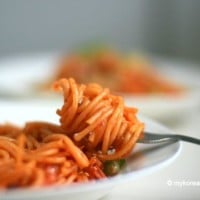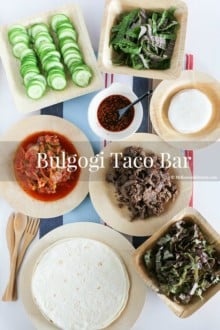Korean fusion pasta – kimchi spaghetti is made with creamy mushrooms, crispy bacon, buttery kimchi and Korea’s secret sauce gochujang! The final touch from the roasted sesame seeds and spring onions are just perfect!

Do you like Kimchi? I do. I wouldn’t say it’s my “favourite” Korean dish, but it somehow engineered my gene that I cannot live without it!
Since you visited my blog, I will safely assume that you already know something about Kimchi.
Kimchi is a very versatile ingredient. Particularly in recent times, fusionisaton of Kimchi has been very popular.
Just to name a few, Kimchi taco, Kimchi omelet and Kimchi quesadillas are already common names in people’s dining life. So today I would like to introduce how I enjoy Kimchi in my home by combining it with spaghetti.
Ingredients for Kimchi Spaghetti, 6 servings
Main
- 500g spaghetti or other pasta
- 160g kimchi
- 80g onion
- 400g bacon
- 120g button mushrooms
- 40g butter
- 2 Tbsp soy sauce
- 2 Tbsp gochujang (Korean chili paste)
- Pinch of fine sea salt
Garnish
- mozzarella cheese, shredded
- roasted sesame seeds
- green onion, thinly sliced
How to Make Kimchi Spaghetti with Bacon
1. Prepare main ingredients. Finely chop Kimchi, onion, bacon. Thin slice the mushroom.

2. Boil some water in a pot and add a dash of salt. Once it starts to boil add the spaghetti.

3. While the spaghetti is getting ready, get other ingredients ready. Heat the wok on high heat and melt the butter. Once the butter is melted, add the mushrooms and stir it well until cooked. When the mushrooms are cooked, take them out and put them onto a plate.

4. Add the bacon in an emptied wok and stir it until cooked. Add the onion. Cook further until the bacon and onion crisps. Once they are cooked, take them out and put them onto a separate plate.

5. Add the kimchi in an emptied wok and stir it until cooked. (Add some vegetable oil if required). Once the Kimchi is cooked, add the mushroom from step 3 and stir them together for 30 seconds. Then reduce the heat to medium to low.

6. By now, the spaghetti should be cooked. Drain the water and add the spaghetti into the wok.

7. Add the bacon (from step 4), the soy sauce and the gochujang on the spaghetti. Mix them all thoroughly.
8. Serve the Kimchi spaghetti on a plate and garnish with your preferred ingredients. (I used mozzarella cheese, sesame seeds and spring onion. I was tempted to add some sesame oil too but I thought that could overpower the taste of the butter I added earlier.)


Kimchi Spaghetti with Bacon
Ingredients
Main
Garnish
- mozzarella cheese , shredded
- toasted sesame seeds
- green onion , thinly sliced
Instructions
- Prepare main ingredients. Finely chop Kimchi, onion, bacon. Thin slice the mushroom.
- Boil some water in a pot and add a dash of salt. Once it starts to boil add the spaghetti.
- While the spaghetti is getting ready, get other ingredients ready. Heat the wok on high heat and melt the butter. Once the butter is melted, add the mushrooms and stir it well until cooked. When the mushrooms are cooked, take them out and put them onto a plate.
- Add the bacon in an emptied wok and stir it until cooked. Add the onion. Cook further until the bacon and onion crisps. Once they are cooked, take them out and put them onto a separate plate.
- Add the kimchi in an emptied wok and stir it until cooked. (Add some vegetable oil if required). Once the Kimchi is cooked, add the mushroom from step 3 and stir them together for 30 seconds. Then reduce the heat to medium to low.
- By now, the spaghetti should be cooked. Drain the water and add the spaghetti into the wok.
- Add the bacon (from step 4), the soy sauce and the gochujang on the spaghetti. Mix them all thoroughly.
- Serve the Kimchi spaghetti on a plate and garnish with your preferred ingredients. (I used mozzarella cheese, sesame seeds and spring onion. I was tempted to add some sesame oil too but I thought that could overpower the taste of the butter I added earlier.)
Nutrition Info (per serving)
The nutrition information shown is an estimate provided by an online nutrition calculator. It should not be considered a substitute for a professional nutritionist’s advice.


